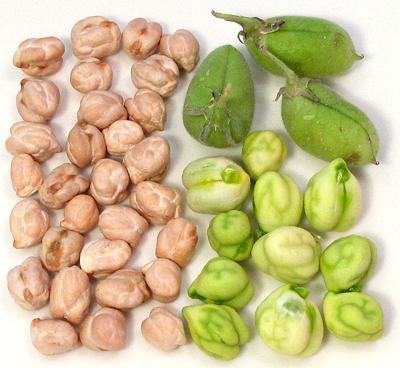 [Garbanzo (Spanish - from Basque); Kabuli Chana (India); Ceci (Italy);
Chiche (France); Cicer arietinum]
[Garbanzo (Spanish - from Basque); Kabuli Chana (India); Ceci (Italy);
Chiche (France); Cicer arietinum]
These are the large light colored chickpea so familiar in the Mediterranean region, the Middle East and North America. They were not introduced into India until the 18th century and came there through Afghanistan, thus named for the Afghan capital of Kabul. Kabuli is the preferred type for growing in more temperate climates. The photo shows dried peas on the left, fresh pods top right and freshly shelled peas lower right. The dried peas were about 3/8 inch in diameter and weighed about 50 to an ounce.
These peas are entirely essential to the cuisines of the Middle East and North Africa. They appear made into a paste and mixed with sesame paste and sometime flavorings in the very popular paste/dip Humus and in recipes of all kinds.
These beans proved 100% fatal to French monks in the monasteries in Sicily because they could not properly pronounce the name in Italian. Anyone who could not pronounce the name properly was immediately slaughtered, along with every other French man, woman and child on Sicily. This event is historically known as "The Sicilian Vespers", since the slaughter began at the Vespers bell (coincidence, not a signal).
More on Beans, Peas & Lentils.
Some recipes, particularly from Armenia, want the chickpeas skinned before cooking. This is done by soaking them for a couple days, changing the water twice a day, then rubbing them between your hands under water. the peas will sink and the skins will float allowing easy removal.
bp_chickz 070404 - www.clovegarden.com